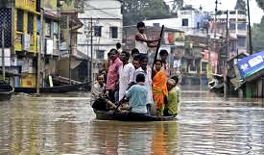A flood vulnerability index for coastal cities and its use in assessing climate change impacts

Worldwide, there is a need to enhance our understanding of vulnerability and to develop methodologies and tools to assess vulnerability. One of the most important goals of assessing coastal flood vulnerability, in particular, is to create a readily understandable link between the theoretical concepts of flood vulnerability and the day-to-day decision-making process and to encapsulate this link in an easily accessible tool. This article focuses on developing a Coastal City Flood Vulnerability Index (CCFVI) based on exposure, susceptibility and resilience to coastal flooding. It is applied to nine cities around the world, each with different kinds of exposure. With the aid of this index, it is demonstrated which cities are most vulnerable to coastal flooding with regard to the system’s components, that is, hydro-geological, socio-economic and politico-administrative. The index gives a number from 0 to 1, indicating comparatively low or high coastal flood vulnerability, which shows which cities are most in need of further, more detailed investigation for decision-makers. Once its use to compare the vulnerability of a range of cities under current conditions has been demonstrated, it is used to study the impact of climate change on the vulnerability of these cities over a longer timescale. The results show that CCFVI provides a means of obtaining a broad overview of flood vulnerability and the effect of possible adaptation options. This, in turn, will allow for the direction of resources to more in-depth investigation of the most promising strategies.
See Also
Report: Cities and flooding
Opinion: Weather dice is loaded
Feature: Future shock
Report: Ecosystem approach to disaster risk reduction
Report: Vulnerability of Kolkata metropolitan area to increased precipitation
Report: Five feet high and rising
Report: Climate vulnerability monitor 2010
Report: Operational research to support mainstreaming...
Report: Resilience to climate change impacts on water...







